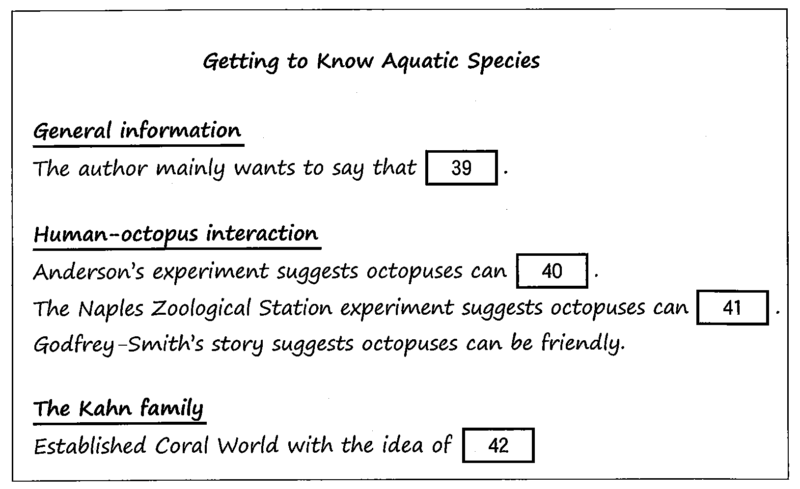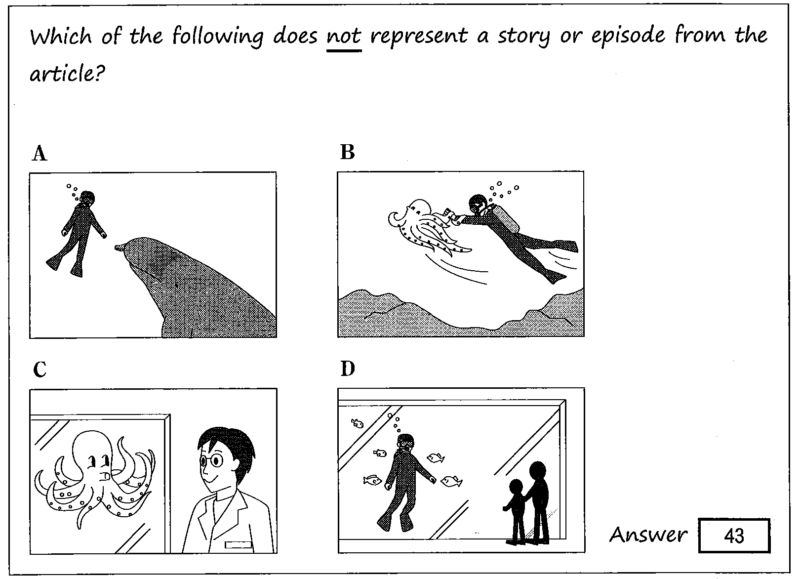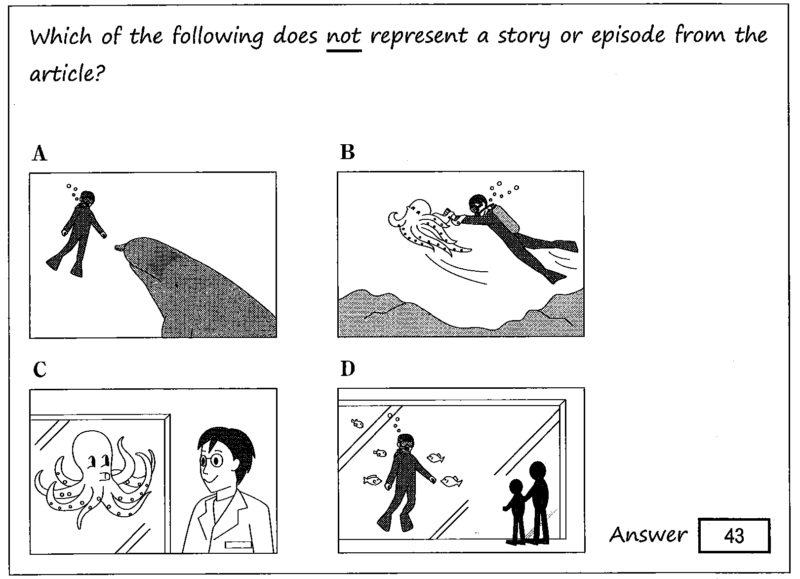2023年度の大学入学共通テスト追試験英語第6問Aの解説をしています。疑問点が残らないよう、解き方の手順も踏まえて一問一問どこよりも丁寧に説明します。
問題
You belong to an English discussion group. Each week, members read an article, create a summary, and make a challenging quiz question to share. For the next meeting, you read the following article.
Getting to Known Aquatic Species
The mysteries of the deep blue sea have fascinated ocean-watchers for millennia. Aquatic being, however, cannot easily get to us. What if we go to them? Despite what you may expect, certain ocean animals will come right up to you. Dan McSweeney, a Hawaii-based underwater research photographer, tells a fascinating story. While he was studying whales underwater, one came charging at him. Whales are huge, so he was worried. The whale stopped, opened its mouth, and “passed” him some tuna. He accepted the gift. McSweeney believes that because of the air bubbles coming from his tank, the whale recognized him as a similar animal and offered the sashimi. Later, the whale came back, and McSweeney returned the food.
Friendly interactions with dolphins or whales are possible, but how about octopuses? Science fiction sometimes describes aliens as looking like octopuses, so this animal group “cephalopods,” which means “head-feet,” may be perceived as being distant from humans. Yet, if you learn more about them, you might be convinced there is the possibility of interaction. Octopuses have long tentacles (arms/legs) extending from soft round bodies. Besides touch and motion, each tentacle experiences smell and taste and has sucking disks, called suckers, that grab and manipulate things. Their eyes, like two independent cameras, can move 80° and focus on two different things at once. UC Berkeley researcher, Alexander Stubbs, confirms that while octopuses sense light and color differently from humans, they do recognize color changes. These features might indicate that are intelligent enough to interact with us. In fact, as article in Everyday Mysteries begins: “Question. Can an octopus get to know you? Answer. Yes.”
Octopuses are known to “return your gaze” when you look at them. They may even remember you. This notion was tested by Roland C. Anderson and his colleagues, who conducted experiments with two similar-looking people wearing the same uniforms. The friendly person, who had fed and socialized with them, got a completely different reaction from the cephalopods than the other person who had not.
When taken from their natural habitat, octopuses can be mischievous, so watch out. They can push the lids off their tanks, escape, and go for a walk. Scientists sometimes get surprise visits. A paper from the Naples Zoological Station, written in 1959, talks about trying to teach three octopuses to pull a lever down for food. Two of them, Albert and Bertram, cooperated with the experiment, but Charles, a clever cephalopod, refused to do so. He shot water at the scientists and ended the experiment by breaking the equipment.
If you are interested in seeing their natural behavior and interactions, getting into the sea and having them come to you might work better. They may even raise a tentacle to motion you over. Around 2007, Peter Godfrey-Smith, a philosophy professor teaching at Harvard University, was home on vacation in Sydney, Australia. Exploring in the ocean, he came across a giant cephalopod. Godfrey-Smith was so impressed by the behavior he witnessed that he started developing philosophy theories based on his observations. Determined to find out what humans could learn from cephalopods, Godfrey-Smith let them guide him. On one ocean trip, another cephalopod took Godfrey-Smith’s colleague by the hand on a 10-minute tour of the octopus’s home, “as if he were being led across the sea floor by a very small, eight-legged child!”
How can you get sea creatures to come to you if you don’t swim? The Kahn family has solved this with “Coral World” in Eilat, Israel. The lowest floor of the building is actually constructed in the Red Sea, creating a “human display.” Rather than the sea-life performances at many aquariums, you find yourself in a “people tank,” where curious fish and sea creatures, swimming freely in the ocean, come to look at you. To make a good impression, you may want to wear nice clothes.
Your summary:

Your quiz question:

問1 Choose the best option for ( 39 ).
- a good place where people can interact with octopuses is the ocean
- eye contact is a key sign of friendship between different species
- interactions with sea creatures can be started by either side
- people should keep sea creatures at home to make friends with them
問2 Choose the best options for ( 40 ) and ( 41 ).
- be a good source for creating philosophical theories
- be afraid of swimmers when they get close to their home
- be uncooperative with humans in a laboratory setting
- compete with other octopuses if they have chances to get treats
- recognize that someone they have met before is kind
- touch, smell, taste, and sense light and color like humans
問3 Choose the best option for ( 42 ).
- attracting more people with a unique aquarium
- creating a convenient place to swim with sea life
- raising more intelligent and cooperative octopuses
- reversing the roles of people and sea creatures
問4 The answer to your quiz question is ( 43 ).
- A
- B
- C
- D
解説 問1
Choose the best option for ( 39 ).
( 39 )に最適な選択肢を選んでください
( 39 )は Your summary: の General information にあります。
The author mainly wants to say that ( 39 ).
著者は主に( 39 )と言いたいと思っています
選択肢を確認しましょう。
1. a good place where people can interact with octopuses is the ocean
タコと触れ合える良い場所は海です
第四段落にこうあります。
When taken from their natural habitat, octopuses can be mischievous, so watch out.
自然の生息地から連れ去られると、タコはいたずらをする可能性があるので注意してください
タコの「自然の生息地」はもちろん海です。「そこから離れる」といたずらをするのは、海にいればいたずらをしないことになります。ですがこの記事にはタコだけではなく、クジラの話もあります。選択肢の内容が、著者の「主に言いたい」ことかというと疑問です。この選択肢は違います。
2. eye contact is a key sign of friendship between different species
アイコンタクトは、異なる種族間の友情の重要な兆候です
「アイコンタクト」について、第三段落にこうあります。
Octopuses are known to “return your gaze” when you look at them.
タコは、見ると「視線を戻す」ことが知られています
ですが、これはタコに関してのみの話です。またそれが「友情の兆候」とは書かれていません。この選択肢は違います。
3. interactions with sea creatures can be started by either side
海の生き物との交流は、どちらの側からでも開始できます
クジラの例では、クジラ側から人間に交流を持ってきました。タコの例では、人間側がえさを与えることで交流を持ちました。水族館の水槽に魚を入れて見るのではなく、海に人間が行って、魚に来てもらう(魚に人間を見てもらう)という施設の話もありました。この選択肢が正解です。
4. people should keep sea creatures at home to make friends with them
仲良くなるために、人々は海の生き物を家で飼うべきです
そのような記述はありません。この選択肢は違います。
ということで、正解は「3」です。

著者の主張的な問題ですから、全部を読んでから最後に取り組むがいいでしょう。
解説 問2
Choose the best options for ( 40 ) and ( 41 ).
( 40 )と( 41 )に最適な選択肢を選んでください
( 40 )と( 41 )は Your summary: の Human-octopus information にあります。
Anderson’s experiment suggests octopuses can ( 40 ).
The Naples Zoological Station experiment suggests octopuses can ( 41 ).
Godfrey-Smith’s story suggests octopuses can be friendly.
アンダーソンの実験は、タコが( 40 )できることを示唆しています
ナポリ動物園の実験は、タコが( 41 )できることを示唆しています
ゴドフリー・スミスの話は、タコが友好的であることを示唆しています
アンダーソンの実験は、第三段落にあります。ナポリ動物園の実験は第四段落にあります。それを踏まえて、選択肢を確認しましょう。
1. be a good source for creating philosophical theories
哲学理論を作成するための良い情報源になる
「哲学理論」について、第五段落にこうあります。
Godfrey-Smith was so impressed by the behavior he witnessed that he started developing philosophy theories based on his observations.
ゴドフリー・スミスは、彼が目撃した行動に非常に感銘を受け、彼の観察に基づいて哲学理論を開発し始めました
ですが、これは「ゴドフリー・スミス」の話です。「アンダーソン」「ナポリ動物園」とは関係ないので、この選択肢は違います。
2. be afraid of swimmers when they get close to their home
泳いでいる人が家に近づくと怖がる
第五段落にこうあります。
On one ocean trip, another cephalopod took Godfrey-Smith’s colleague by the hand on a 10-minute tour of the octopus’s home,
ある海の旅で、別の頭足類がゴドフリー・スミスの同僚の手を取り、タコの家を 10 分間ツアーしました
家に近づくのを怖がっていません。この選択肢は違います。
3. be uncooperative with humans in a laboratory setting
実験室の環境で人間に協力しない
「実験の協力」について、第四段落にこうあります。
Two of them, Albert and Bertram, cooperated with the experiment, but Charles, a clever cephalopod, refused to do so.
そのうちの 2 匹、アルバートとバートラムは実験に協力しましたが、賢い頭足類のチャールズは協力を拒否しました
これは「ナポリ動物園」の実験です。ということで、( 41 )にこの選択肢が入ります。
4. compete with other octopuses if they have chances to get treats
おやつをもらえるチャンスがあれば、他のタコと競争する
そのような記述はありません。この選択肢は違います。
5. recognize that someone they have met before is kind
以前に会ったことがある人は親切だと認識する
第三段落にこうあります。
The friendly person, who had fed and socialized with them, got a completely different reaction from the cephalopods than the other person who had not.
頭足類に餌を与えて交流したフレンドリーな人は、そうしなかった人と比べて、頭足類からまったく異なる反応を示されました
これは「アンダーソン」の実験です。ということで、( 40 )にこの選択肢が入ります。
6. touch, smell, taste, and sense light and color like humans
人間と同じように、触ったり、嗅いだり、味わったり、光や色を感じたりする
第二段落にこうあります。
Besides touch and motion, each tentacle experiences smell and taste and has sucking disks, called suckers, that grab and manipulate things.
接触や動きに加えて、各触手は匂いや味を感じ、物をつかんで操作する吸盤と呼ばれる吸い付く円盤を持っています
さらにこうあります。
UC Berkeley researcher, Alexander Stubbs, confirms that while octopuses sense light and color differently from humans, they do recognize color changes.
カリフォルニア大学バークレー校の研究者である Alexander Stubbs は、タコは人間とは異なる方法で光と色を感じますが、色の変化を認識していることを確認しています
確かにタコはこの選択肢にあるようなことができます。ですが、これは「アンダーソン」や「ナポリ動物園」の実験とは関係ありません。この選択肢は違います。
ということで、正解は( 40 )→「5」、( 41 )→「3」です。

「アンダーソン」とある第三段落を読んで、選択肢から( 40 )の内容を探す。「ナポリ動物園」とある第四段落を読んで、選択肢から( 41 )の内容を探す。という手順で解くとよいかと思います。
解説 問3
Choose the best option for ( 42 ).
( 42 )に最適な選択肢を選んでください
( 42 )は Your summary: の The Kahn family にあります。
Established Coral World with the idea of ( 42 ).
( 42 )の発想でコーラルワールドを設立した
選択肢を確認しましょう。
1. attracting more people with a unique aquarium
ユニークな水族館でより多くの人を魅了
2. creating a convenient place to swim with sea life
海の生き物と一緒に泳ぐのに便利な場所を作る
3. raising more intelligent and cooperative octopuses
より知的で協力的なタコを育てる
4. reversing the roles of people and sea creatures
人と海の生き物の役割を逆転させる
第六段落にこうあります。
Rather than the sea-life performances at many aquariums, you find yourself in a “people tank,” where curious fish and sea creatures, swimming freely in the ocean, come to look at you.
多くの水族館で見られる海洋生物のショーではなく、海の中を自由に泳ぐ好奇心旺盛な魚や海の生き物が、あなたを見に来る「人間の水槽」にいることに気づきます
「コーラルワールド」は人が魚を見るのではなく、魚が人を見に来る施設です。「1」のユニークな水族館とも考えられそうですが、「多くの人を魅了する」という内容ではありません。「人と海の生き物の役割を逆転させる」という「4」の内容の方が本文に合っています。
ということで、正解は「4」です。

The Kahn family は第六段落にありますので、そこを読んでから解答します。少しわかりづらい表現ですが、「human display / 人間の展示」「people tank / 人々の水槽」などから、想像を働かせたいです。
解説 問4
The answer to your quiz question is ( 43 ).
あなたへのクイズの答えは( 43 )です
Your quiz question: は、こうなっています。
Which of the follow does not represent a story or episode from the article?
記事のストーリーまたはエピソードを表していないのは次のうちどれですか

記事のエピソードを表していないものを選ぶことに注意です。
「A」は第一段落の、クジラとのエピソードです。
While he was studying whales underwater, one came charging at him.
彼が水中でクジラを研究していると、1 頭が彼に向かって突進してきました
「B」は第五段落の、タコが家に連れて行ってくれたエピソードです。
On one ocean trip, another cephalopod took Godfrey-Smith’s colleague by the hand on a 10-minute tour of the octopus’s home,
ある海の旅で、別の頭足類がゴッドフリー・スミスの同僚の手を取り、タコの家を 10 分間ツアーしました
「C」は第三段落の、タコが餌をくれる人に対して態度が違うというエピソードです。
The friendly person, who had fed and socialized with them, got a completely different reaction from the cephalopods than the other person who had not.
頭足類に餌を与えて交流したフレンドリーな人は、そうしなかった人と比べて、頭足類からまったく異なる反応を示されました
「D」は普通の水族館の絵でしょうが、問3で確認したとおり、第六段落の「コーラルワールド」のものとは違います。
ということで、エピソードを表していないものを選ぶので、正解は「4」です。

「C」がそのエピソードだとは断言しづらいですね。「D」が「コーラルワールド」のエピソードを表していないことから判断しましょう。



コメントをどうぞ